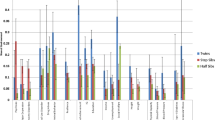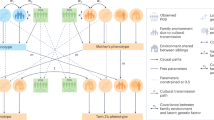Abstract
Since Galton's time, critics of the twin method have rejected the evidence of genetic differences in human behavior, because the twin method assumes that identical and fraternal pairs have equally similar environments. Twins whose genetic similarity is misperceived by themselves and others provide a critical test of the adequacy of this assumption. The relative effects of perceived and actual genetic similarity on cotwin differences in cognitive, personality, and physical development were assessed in a sample of young, adolescent twins whose genetic similarity was often misperceived. Twins' responses to questions about their own and other's judgments about their zygosity and physical similarity, and the ratings of similarity by eight judges, were used to estimate the perceived similarity of the twins. Actual zygosity was established by matching cotwins on 12 or more blood group loci. Perceived zygosity and perceived similarity by self and others were found to be insignificant biases in the twin study method.
Similar content being viewed by others
References
Benton, A. L. (1963.The Revised Visual Retention Test, Form C, William C. Brown, Dubuque, Ia.
Burgemeister, B. B., Blum, L. H., and Lorge, I. (1959).Columbia Mental Maturity Scale, Harcourt, Brace, & World, New York.
Carter-Saltzman, L., and Scarr, S. (1977). MZ or DZ? Only your blood grouping laboratory knows for sure.Behav. Genet.,7(4):273–280.
Cederlof, R., Friberg, L., Johsson, E., and Kaij, L. (1961). Studies on similarity diagnosis in twins with the aid of mailed questionnaires.Acta Genet.,11:338.
Cohen, D. J., Dibble, E., Grawe, J. M., and Pollin, W. (1973). Separating identical from fraternal twins.Arch. Gen. Psychiat.,29:465–469.
Coopersmith, S. (1967).Antecedents of Self Esteem, Freeman, San Francisco.
Dunn, L. M. (1959).Peabody Picture Vocabulary Test, American Guidance Service, Circle Pines, Minn.
Eysenck, S. B. G. (1965).Junior Eysenck Personality Inventory, Educational and Industrial Testing Service, San Diego, Calif.
Gottesman, I. I. (1963). Heritability of personality: A demonstration.Psychol. Monogr.,77:Spring, Whole No. 572.
Jones, H. E. (1955). Perceived differences among twins.Eugen. Quart.,5:98–102.
Kamin, L. J. (1974).The Science and Politics of I.Q., Lawrence Erlbaum Associates, Potomac, Md.
Loehlin, J. C. and Nichols, R. C. (1976).Heredity, Environment, and Personality, University of Texas Press, Austin, Tex.
Nichols, R. C., and Bilbro, W. C. (1966). The diagnosis of twin zygosity.Acta Genet.,16:265–275.
Scarr, S. (1968). Environmental bias in twin studies.Eugen. Q.,15:34–40.
Smith, R. T. (1965). A comparison of socioenvironmental factors in monozygotic and dizygotic twins, testing an assumption. In Vandenberg, S. G. (ed.),Methods and Goals in Human Behavior Genetics, Academic Press, New York.
Author information
Authors and Affiliations
Additional information
This research was supported by grants from the National Institute of Child Health and Human Development (HD-06502) and the W. T. Grant Foundation.
Rights and permissions
About this article
Cite this article
Scarr, S., Carter-Saltzman, L. Twin method: Defense of a critical assumption. Behav Genet 9, 527–542 (1979). https://doi.org/10.1007/BF01067349
Received:
Accepted:
Issue Date:
DOI: https://doi.org/10.1007/BF01067349




